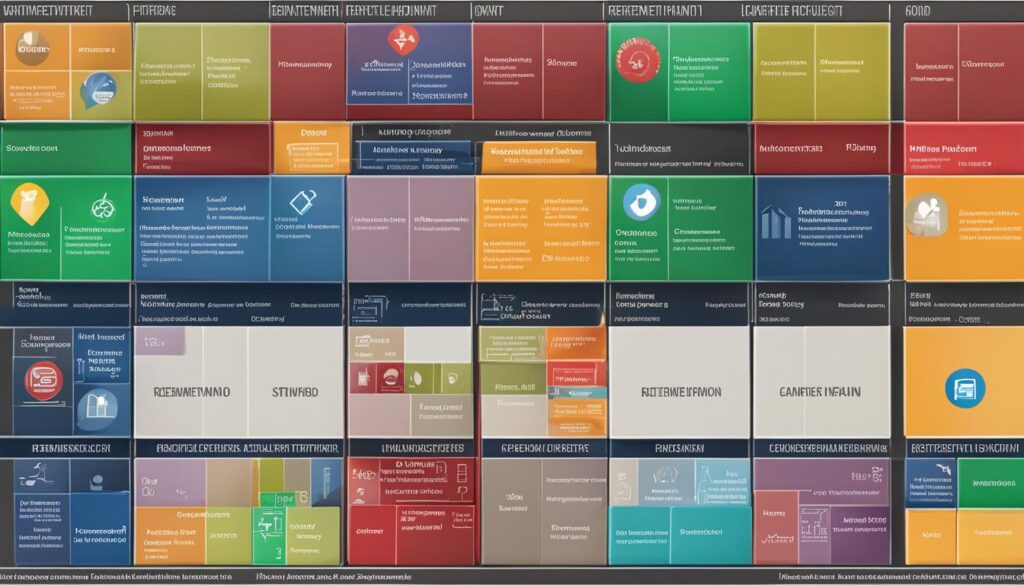In today’s rapidly changing landscape, retirement planning has become a critical consideration for individuals as they navigate their golden years. However, research has shown that retirement planning is still relatively undefined and lacking in comprehensive investigation. To truly understand the process of retirement planning, it is essential to explore the cognitive factors that shape strategic decision-making and inform individuals’ preparation for their future.
Key Takeaways:
- Retirement planning is a crucial concern for individuals in today’s workforce.
- Current research indicates a need for a more comprehensive understanding of retirement planning.
- Cognitive factors, such as heuristics, play a significant role in shaping retirement planning.
- Strategic decision-making is essential for effective integration of work and retirement research domains.
- By considering heuristics and cognitive antecedents, individuals can navigate retirement planning with greater success and confidence.
The Impact of Retirement Process on Post-Retirement Adjustment and Well-being
Retirement is a significant life transition that can have a profound impact on individuals’ adjustment and well-being in the post-retirement phase. Extensive research has been conducted to understand the retirement process and its implications for retirees. The retirement process encompasses various stages, including the decision to retire, the actual retirement event, and the subsequent adjustment period.
Studies have shown that the retirement process can have both positive and negative effects on individuals’ well-being. Retirement can provide opportunities for leisure, rest, and pursuing personal interests, leading to increased life satisfaction and overall well-being. However, retirement can also be accompanied by challenges such as loss of social connections, changes in daily routines, and financial uncertainties, which may contribute to post-retirement adjustment difficulties and decreased well-being.
The retirement process is not a one-size-fits-all experience, as it is influenced by factors such as individual characteristics, financial resources, social support networks, and health status. It is crucial to recognize these individual differences and tailor interventions and support systems to promote positive post-retirement adjustment and well-being. By understanding the impact of the retirement process on individuals’ lives, professionals can develop strategies and programs that facilitate a smooth transition into retirement and enhance retirees’ overall quality of life.
“Retirement is not the end of the road; it is the beginning of the open highway.” – Unknown
The Role of Post-Retirement Activities
Engaging in meaningful post-retirement activities is essential for retirees’ overall well-being and adjustment. Research has identified that involvement in social, leisure, and productive activities can positively influence retirees’ physical and mental health, sense of purpose, and life satisfaction. By participating in activities such as volunteering, pursuing hobbies, or part-time work, retirees can maintain a sense of structure, social connections, and personal fulfillment in the post-retirement phase.
| Activity Type | Benefit |
|---|---|
| Social Activities | Enhanced social connections and reduced feelings of isolation |
| Leisure Activities | Increased sense of enjoyment and fulfillment |
| Productive Activities | Greater sense of purpose and satisfaction |
By actively engaging in post-retirement activities that align with their interests and values, retirees can navigate the transition more smoothly and experience a higher level of well-being in the post-retirement phase.
Overall, understanding the impact of the retirement process on post-retirement adjustment and well-being is crucial for individuals, organizations, and policymakers. By recognizing the challenges and opportunities associated with retirement, professionals can develop effective strategies and interventions to support retirees in achieving a fulfilling and satisfying post-retirement life.
Retirement Planning and Changing Nature of Work
The changing nature of work has a significant impact on retirement planning. As job mobility increases and life expectancies lengthen, organizations are recognizing the importance of work flexibility and work-life balance. Retirement is no longer viewed as an abrupt end to one’s career but rather a transition involving phased withdrawal from the workforce and work-recovery cycles. Understanding the relationship between retirement planning and the changing nature of work is crucial for individuals as they prepare for retirement.
In today’s dynamic work environment, employees are seeking a balance between their professional and personal lives. The traditional notion of retiring at a certain age and completely stopping work is being replaced by more flexible arrangements. Many individuals are opting for bridge-employment, which involves gradual reduction of work hours or transitioning to part-time work before fully retiring. This allows individuals to maintain a sense of purpose, financial stability, and social connections during the transition to retirement.
“Retirement is no longer viewed as an abrupt end to one’s career but rather a transition involving phased withdrawal from the workforce and work-recovery cycles.”
Work-life balance is now a key consideration in retirement planning. Individuals are looking for ways to integrate their personal goals and leisure activities into their retirement plans. They want to ensure that they have enough time to pursue hobbies, spend time with family and friends, and engage in activities that bring them joy and fulfillment. By aligning retirement plans with their desired work-life balance, individuals can create a retirement that meets their personal and professional needs.
In summary, retirement planning is closely intertwined with the changing nature of work. With increased job mobility and longer life expectancies, individuals are seeking more flexible retirement arrangements that allow for a better work-life balance. By understanding and adapting to these changes, individuals can prepare for a retirement that aligns with their values, goals, and overall well-being.

Empirical Evidence on Psychological Antecedents of Retirement Planning
Retirement planning is a complex process that is influenced by various psychological factors. Understanding these psychological antecedents is crucial for individuals seeking to effectively prepare for retirement. Research in the field has identified several key cognitive factors that impact retirement planning and decision-making.
Cognitive factors: Cognitive factors such as cognitive abilities, beliefs, and attitudes play a significant role in retirement planning. For example, individuals with higher levels of financial literacy are more likely to engage in retirement planning and make informed financial decisions. Similarly, beliefs and attitudes about retirement, such as perceptions of retirement as a positive or negative experience, can influence retirement planning behaviors.
“Retirement planning is not just about financial considerations. It also involves psychological factors such as beliefs, attitudes, and cognitive abilities.”
Decision-making: The decision-making process is another psychological antecedent that impacts retirement planning. Individuals engage in a series of decisions related to retirement, such as when to retire, how much to save, and how to allocate their retirement funds. Cognitive factors, such as risk perception and decision-making styles, can influence these retirement-related decisions.
Transition adjustment: Retirement is a significant life transition that requires individuals to adjust to a new lifestyle and identity. Psychological antecedents related to transition adjustment, such as self-esteem, sense of purpose, and social support, can impact the retirement planning process. These factors influence how individuals adapt to retirement and cope with the changes it brings.
In summary, retirement planning is not just a financial process. It involves various psychological antecedents that shape individuals’ decision-making and adjustment to retirement. Understanding these cognitive factors, decision-making processes, and transition adjustment aspects is crucial for effective retirement preparation. By considering these psychological factors, individuals can make informed choices and navigate the retirement transition more successfully.

A Holistic Perspective on Retirement Planning
Retirement planning requires a holistic perspective that takes into account the complexities of retirement decisions. It is no longer a discrete act but involves pluralistic pathways and ongoing work-life decisions. By considering various factors from decision-making to transition adjustment and career development, individuals can understand the full implications of retirement planning.
A holistic approach to retirement planning emphasizes the importance of conceptual frameworks in guiding individuals’ thinking and actions. One such framework is the theory of planned behavior, which focuses on understanding the intentions and plans individuals develop for retirement. This framework provides valuable insights into the cognitive factors that influence retirement decisions and subsequent adjustment and well-being.
“Retirement planning is like planting a tree. The earlier you start, the stronger the foundation, and the more fruitful the golden years will be.”
The Role of Conceptual Frameworks
Conceptual frameworks offer a structured way to think about retirement planning and its various dimensions. They provide a roadmap for individuals to navigate the complex landscape of retirement decisions and make informed choices. These frameworks integrate psychological factors, social influences, and personal values to guide individuals in developing retirement intentions and plans that align with their goals and aspirations.
By adopting a holistic perspective and leveraging conceptual frameworks, individuals can approach retirement planning with clarity and purpose. They can assess their financial needs, consider lifestyle preferences, and explore opportunities for continued engagement and fulfillment during their retirement years.
Table: Key Factors in Holistic Retirement Planning
| Factors | Description |
|---|---|
| Financial Preparedness | Assessing savings, investments, and retirement income sources to ensure financial security. |
| Lifestyle Considerations | Exploring leisure activities, travel plans, and social connections for a fulfilling retirement lifestyle. |
| Health and Wellness | Prioritizing physical and mental well-being through healthy habits, healthcare planning, and insurance coverage. |
| Emotional Readiness | Preparing for the emotional aspects of retirement, such as identity transformation and maintaining a sense of purpose. |
| Social Support | Nurturing relationships and building a network of support to maintain social connections and combat isolation. |

Addressing the Antecedent-Outcome Gap in Retirement Planning
Retirement research often overlooks the influence of normative changes associated with retirement on younger cohorts’ approach to employment and retirement planning. This antecedent-outcome gap is crucial to understanding the impact of retirement decisions on ongoing work-life decisions and future post-retirement well-being. To bridge this gap, comprehensive assessments of retirement plans and intentions are necessary to effectively integrate retirement research paradigms.
In many cases, individuals fail to recognize the long-term implications of retirement decisions and the interconnectedness of retirement planning with other aspects of life. By addressing the antecedent-outcome gap, researchers and practitioners can better support individuals in making informed retirement decisions that align with their overall life goals and aspirations.
Exploring the antecedent-outcome gap in retirement planning requires careful consideration of various factors that influence retirement decisions. These factors may include financial stability, health considerations, family dynamics, and personal values. By understanding the complex interplay between these factors, researchers can develop comprehensive frameworks and interventions that facilitate effective retirement planning and decision-making.
| Factors | Description |
|---|---|
| Financial Stability | The individual’s financial resources and retirement savings |
| Health Considerations | The individual’s physical and mental well-being |
| Family Dynamics | The individual’s relationships and responsibilities within the family |
| Personal Values | The individual’s beliefs, principles, and priorities |
By addressing the antecedent-outcome gap in retirement planning, researchers and practitioners can guide individuals towards making informed and holistic retirement decisions that promote overall well-being and life satisfaction. It is crucial to consider the interconnectedness of retirement planning with other aspects of life to ensure a smooth transition into the golden years.
Retirement Planning Categories and Paradigm Relations
The landscape of retirement planning can be categorized into two perspectives: decision-making and transition adjustment. These categories have direct relations with newer retirement research paradigms, providing valuable insights into the complex process of retirement planning.
In the decision-making perspective, individuals make strategic choices regarding retirement, considering factors such as financial stability, health, and personal goals. This perspective emphasizes the importance of cognitive factors in shaping retirement plans and intentions. Understanding the decision-making process can help individuals navigate the complexities of retirement and make informed choices that align with their desired outcomes.
The transition adjustment perspective, on the other hand, focuses on the psychological and social aspects of retirement. It explores how individuals adapt to the changes that retirement brings, such as the loss of work identity, changes in social relationships, and the search for new purpose and meaning in life. Transition adjustment research provides valuable insights into the challenges and opportunities that arise during the retirement journey.
The Role of Cognitive Factors in Retirement Decision-making
Research has shown that cognitive factors play a crucial role in retirement decision-making. Heuristics, or mental shortcuts, shape the way individuals perceive and evaluate retirement options. These heuristics are influenced by a variety of factors, including societal norms, personal beliefs, and past experiences. By understanding the cognitive processes underlying retirement decision-making, individuals can make more informed choices that align with their values and preferences.
“Retirement planning is not just about financial preparation, but also about understanding the psychological and social aspects of the transition. By considering both decision-making and transition adjustment perspectives, individuals can navigate the complexities of retirement and create a fulfilling post-work life.”
– Retirement Planning Expert
| Retirement Planning Categories | Retirement Research Paradigms |
|---|---|
| Decision-Making Perspective | Process-Models of Retirement |
| Transition Adjustment Perspective | Psychological Antecedents of Retirement |
The table above summarizes the relationship between retirement planning categories and corresponding research paradigms. It highlights the need for a comprehensive understanding of both decision-making and transition adjustment perspectives to effectively navigate the retirement planning process.

- Decision-making perspective: In this perspective, individuals make strategic choices regarding retirement, considering factors such as financial stability, health, and personal goals.
- Transition adjustment perspective: This perspective focuses on the psychological and social aspects of retirement, exploring how individuals adapt to the changes that retirement brings.
By considering both decision-making and transition adjustment perspectives, individuals can gain a comprehensive understanding of retirement planning and make informed choices that align with their values and aspirations. This holistic approach ensures a smoother transition into retirement and a more fulfilling post-work life.
The Value of Retirement Intentions in Retirement Planning
Retirement intentions play a crucial role in retirement planning, providing valuable insights into individuals’ future decisions and outcomes. When it comes to preparing for retirement, understanding one’s intentions is essential in making informed choices that align with personal goals and aspirations.
Research has shown that retirement intentions directly impact retirement decisions and subsequent adjustment and well-being during the post-retirement phase. By examining self-reported plans and intentions, researchers have been able to gain a deeper understanding of the factors influencing retirement outcomes.
A study on bridge-employment, a form of phased retirement, revealed that retirement intentions significantly predict retirement outcomes. Individuals who had clear intentions and plans for their post-retirement employment experienced greater satisfaction and well-being in their golden years.
By considering retirement intentions, individuals can develop a comprehensive retirement plan that suits their needs and preferences. Whether it involves continued work, leisure activities, or pursuing new interests, aligning retirement intentions with desired outcomes can lead to a more fulfilling and purposeful retirement.
“Retirement intentions offer valuable insights into retirement planning, influencing retirement decisions and subsequent adjustment and well-being.”
Retirement Intentions: Key Points
- Retirement intentions provide insights into individuals’ future decisions and outcomes.
- They directly impact retirement decisions and subsequent well-being during the post-retirement phase.
- Studies show that clear retirement intentions predict more satisfying retirement outcomes.
- Aligning retirement intentions with desired outcomes leads to a more fulfilling retirement.
| Retirement Intentions | Impact on Retirement Planning |
|---|---|
| Clear and well-defined intentions | Lead to more informed retirement decisions and better adjustment. |
| Unclear or ambiguous intentions | Result in uncertainty and potential challenges during retirement. |
| Alignment of intentions with desired outcomes | Leads to a more fulfilling and purposeful retirement. |
Shared Risk and New Models of Retirement Income
Retirement income is a crucial element of retirement planning, and as the retirement landscape evolves, new models are emerging to provide individuals with greater financial security. One such model is the concept of shared risk, which combines elements of defined contribution and defined benefit plans to offer a more balanced approach to retirement savings. This model aims to mitigate the limitations of traditional pension plans and provide retirees with a stable income stream throughout their golden years.
Shared risk pension plans function by pooling the contributions of participating employees and investing them in a diverse portfolio of assets. The plan’s administrators then assume the investment risk, meaning that retirees are less vulnerable to market fluctuations and economic downturns. This arrangement offers retirees a more predictable income stream, as their retirement benefits are not solely dependent on the performance of their individual investment accounts.
Additionally, shared risk plans often incorporate features such as guaranteed minimum benefits and cost-of-living adjustments to ensure that retirees’ purchasing power is protected against inflation. These mechanisms provide retirees with greater peace of mind, knowing that their retirement income will retain its value over time. By embracing shared risk models, individuals can enhance their retirement planning strategy and achieve greater financial stability in their post-working years.
New Pension Models: A Comparison
| Retirement Income Model | Key Features |
|---|---|
| Traditional Defined Benefit Plan | – Fixed monthly retirement income – Employer assumes investment risk – Provides lifetime income – Typically based on salary and years of service – Benefits may be subject to inflation adjustments |
| Defined Contribution Plan (e.g., 401(k)) | – Individual account balance – Employee assumes investment risk – Income based on contributions and investment returns – No lifetime income guarantee – Benefits may be subject to market fluctuations |
| Shared Risk Plan | – Pooling of contributions – Balanced investment portfolio – Plan assumes investment risk – Offers predictable income stream – May include inflation adjustments and other features |
Above is a comparison of traditional defined benefit plans, defined contribution plans, and shared risk plans. This table showcases the distinctive features of each model and highlights the advantages of shared risk plans, such as predictable income and reduced investment risk. Understanding these new pension models and their implications for retirement planning can empower individuals to make informed decisions about their financial future.
The Role of Home Equity in Retirement Planning
Retirement planning involves careful consideration of various factors, including the role of home equity. Home equity, which refers to the value of a homeowner’s property minus any outstanding mortgage balance, can play a significant role in retirement savings. Utilizing home equity effectively can provide retirees with additional financial resources to support their post-retirement lifestyle.
One option to leverage home equity is through a reverse mortgage. A reverse mortgage allows homeowners aged 62 and older to borrow against the equity in their homes. The loan is typically repaid when the homeowner either sells the property, moves out of the home, or passes away. This can be a viable option for retirees who wish to access the value of their homes without selling or downsizing.
Another approach is downsizing. By selling their current home and moving into a smaller, less expensive property, retirees can unlock the equity tied up in their homes. The proceeds from the sale can then be used to supplement retirement savings or cover ongoing expenses. Downsizing can also reduce housing-related costs, such as property taxes, maintenance, and utilities.
It is important for individuals to carefully evaluate their options and assess the potential impact on their financial situation before utilizing home equity in retirement planning. While home equity can provide valuable resources, it is essential to consider factors such as housing market conditions, future expenses, and personal preferences. Consulting with financial advisors specializing in retirement planning can help individuals make informed decisions based on their unique circumstances.
| Benefits of Utilizing Home Equity in Retirement Planning | Considerations |
|---|---|
| Access to additional financial resources | Evaluation of housing market conditions |
| Flexibility in managing retirement savings | Consideration of future expenses |
| Potential reduction in housing-related costs | Personal preferences and lifestyle choices |
By understanding the role of home equity in retirement planning, individuals can make informed decisions to optimize their retirement savings and secure their financial well-being in the golden years.
Conclusion
In conclusion, effective retirement planning is a complex process that involves strategic decision-making and careful consideration of individual circumstances. It is essential to understand the changing nature of work, address the antecedent-outcome gap, and explore new models of retirement income to ensure a secure and fulfilling retirement.
Retirement planning can be shaped by heuristics, which are mental shortcuts that individuals use to make decisions. By understanding these cognitive processes and incorporating them into retirement planning, individuals can make more informed choices.
Furthermore, taking a holistic perspective is crucial for comprehensive retirement planning. This includes considering factors such as decision-making, transition adjustment, and career development to fully understand the implications of retirement planning.
Lastly, individuals must prioritize retirement savings and engage in life planning to optimize their financial resources for the golden years. By carefully managing their retirement savings and making strategic decisions, individuals can secure their financial well-being and enjoy a fulfilling retirement.
FAQ
What is retirement planning?
Retirement planning refers to the process of making strategic decisions and considering individual circumstances to ensure a secure and fulfilling retirement.
How do heuristics shape retirement planning?
Heuristics, or mental shortcuts, play a significant role in guiding retirement planning decisions and shaping individuals’ approach to securing their golden years.
What impact does the retirement process have on post-retirement adjustment and well-being?
The retirement process can significantly impact an individual’s adjustment and well-being after retirement. Understanding the potential challenges and opportunities is crucial for a successful transition.
How does retirement planning relate to the changing nature of work?
With increased job mobility and longer life expectancies, retirement planning needs to consider the evolving work landscape and the importance of work-life balance.
What are the psychological antecedents of retirement planning?
Psychological factors such as decision-making, transition adjustment, and career development all influence retirement planning and subsequent adjustment and well-being.
How can a holistic perspective benefit retirement planning?
Taking a holistic approach to retirement planning, which considers decision-making, transition adjustment, and career development, helps individuals understand the full implications of their retirement plans.
What is the antecedent-outcome gap in retirement planning?
The antecedent-outcome gap refers to the need to bridge the gap between retirement planning and its impact on ongoing work-life decisions and future post-retirement well-being.
How do retirement planning categories relate to retirement research paradigms?
Retirement planning categories such as decision-making and transition adjustment have direct relations to newer retirement research paradigms and can provide valuable insights into retirement outcomes.
What is the value of retirement intentions in retirement planning?
Retirement intentions, operationalized as self-reported plans, play a significant role in predicting retirement outcomes and subsequent adjustment and well-being.
What are the new models of retirement income?
New models such as shared risk and portfolio pension plans are emerging to provide retirement income security through a combination of defined contribution and defined benefit plans.
How does home equity contribute to retirement planning?
Home equity can be utilized as a source of retirement savings through options like reverse mortgages or downsizing, providing retirees with additional financial resources.
Should I Avoid Following Common Retirement Planning Strategies?
Should I avoid following common retirement planning strategies? It depends. While many people find success in these strategies, it is important to understand that they may not suit everyone’s needs. It is recommended to consider your individual circumstances and priorities before making any decisions. Seeking retirement planning tips for independent decisions is advisable to ensure a customized approach that aligns with your specific goals and requirements.

